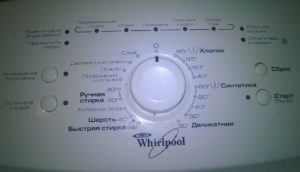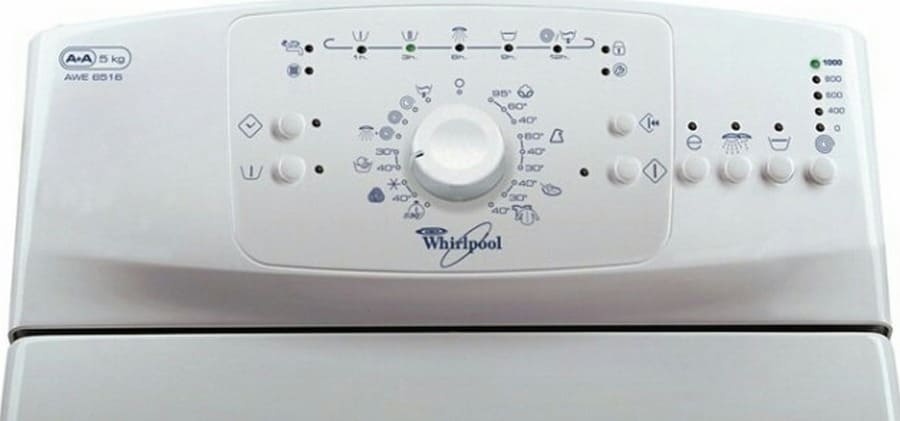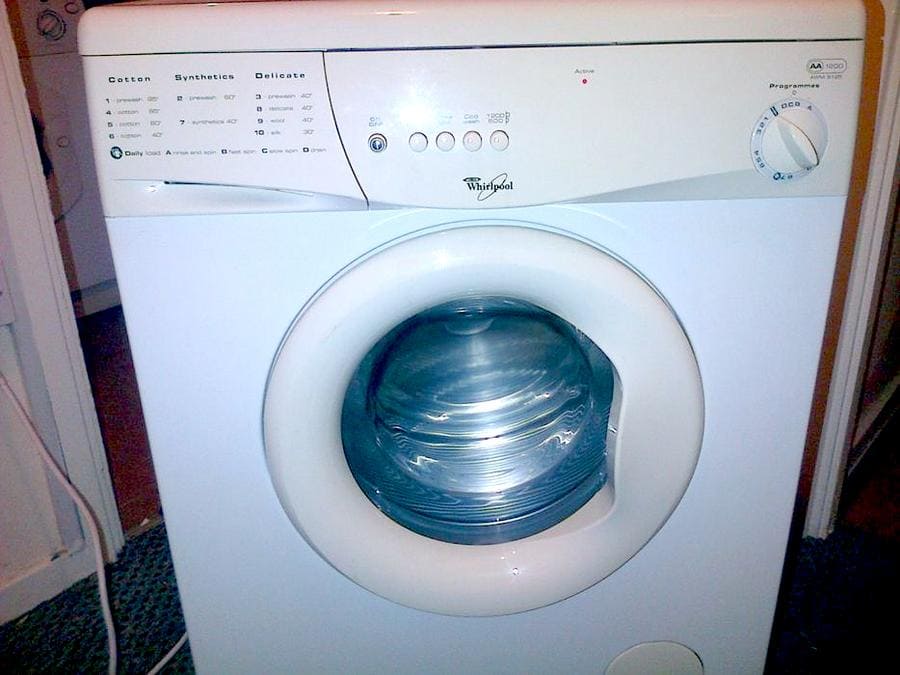 Whirlpool is one of the most famous washing machine manufacturers in the world. A well-known brand guarantees the durability and reliability of the device; if a breakdown occurs, the built-in diagnostic system will quickly detect the faulty unit. Of course, in order to accurately identify the cause of the malfunction and correct it, you need to learn to understand the error codes of Whirlpool washing machines.
Whirlpool is one of the most famous washing machine manufacturers in the world. A well-known brand guarantees the durability and reliability of the device; if a breakdown occurs, the built-in diagnostic system will quickly detect the faulty unit. Of course, in order to accurately identify the cause of the malfunction and correct it, you need to learn to understand the error codes of Whirlpool washing machines.
Washing machine display

If a problem is detected, the washing machine stops working and immediately displays an error message. Signaling methods depend on the specific model, rather, on its age. Most new models are equipped with a display with a segment indicator on which one or another code is displayed.
Most old washing mashines also have a built-in diagnostic system, only the results of its operation are communicated to the user in a different way, by turning on the lamps on the display panel. If you look at the documentation for the machine, you can easily find a table that allows you to clearly determine the type of error and identify the faulty unit.
Washing machines without a display use a lack of water supply indicator and a number of operating mode indicators to display the error code:
- prewash;
- wash;
- rinsing;
- stop;
- spin
In addition to them, indicators are used to indicate an open hatch and a dirty drain filter. Combinations of these lamps with the “Service” lamp make it possible to clearly identify a breakdown.
It doesn’t matter how exactly the device signals an error, as soon as this occurs, you need to immediately take measures to correct the situation. It is important to understand that ignoring even a seemingly insignificant error may lead to the need to replace a number of expensive device components in the near future.
Service test

The Whirlpool washing machine automatically tests the main components and assemblies, however, the diagnostic program can be forced to start. This can be useful if questions arise regarding the operation of the machine (the device takes too long to draw water at normal pressure in the system, the drain is too noisy, etc.).
The classic washing machine test is started using the following sequence of actions:
- Launching the "Drain" program.
- Cancel the program.
- Selecting the “Drain” program without starting.
- Five presses of the soak button.
As a result of these actions, the device will begin a test wash. During the test, the drum will be filled, rotation will begin, water will be heated, drained, and spinned. If you need to skip a step, you just need to press the soak button once.
As soon as the program runs on the display (for machines without a display, a combination on the display panel), an error code corresponding to the detected malfunction will be displayed.
List of the most common breakdowns
Since a modern washing machine is a complex device, it consists of a number of components and assemblies, the list of potential breakdowns is extremely extensive. Among other things, there are a number of specific malfunctions that occur most often:
- blockages in the drain tract;
- jamming or breakdown of the pump;
- leaking tank seals;
- wear of electric motor brushes;
- belt breakage (in belt-driven machines);
- bearing wear;
- failure of the heater or thermostat;
- various failures of the control module.
Another common problem that is typical for both vertical loading machines and traditional front-loaders is the entry of foreign objects into the tank. Despite the apparent insignificance of the incident, in most cases, to solve the problem you will have to almost completely disassemble the washing machine.
Reset error

The appearance of an error message is not always a sign of a serious accident. The reason for this situation could be, for example, a failure caused by a voltage drop. If the error appears for the first time, there is no need to panic; first, you should try to reset the error. A few simple steps will restore the device's functionality or eliminate the possibility of an accidental system failure.
To reset the error you need to do the following:
- disconnect the washing machine from the network (unplug the plug from the socket)
- keep it switched off for at least 15 minutes;
- turn it on again and try to continue washing.
If there was a failure, the machine will continue to work normally, otherwise you will have to study the instructions, figure out what this error means and look for a way to solve the problem.
Fault codes
The machine signals all detected faults using error codes. Most often this is a letter of the Latin alphabet and two numbers after it.
e01
If the washing machine indicator displays error e01, on some FDL or FDU models, this means that the loading hatch is open. The reason for the message to appear may be either a truly open hatch or a faulty lock. To determine what exactly is causing the error, just open the door and close it again, trying to press it harder. If the message disappears, do not worry, otherwise you will have to disassemble the washing mashine and change the blocker.
f01 (FH)
This message indicates that the machine cannot draw water normally. There are several reasons for the error to occur. This could be a simple lack of pressure in the water supply, contamination of the filter mesh, a bend or violation of the integrity of the hose, a broken valve, or improper operation of the pressure switch. To eliminate the breakdown, you should make sure that there is water in the water supply, remove and clean the inlet filter, and possibly replace the sensor or valve.
f02
The “AquaStop” sensor has triggered – the water supply has stopped. This happens if the machine detects a leak in the pan or the inlet valve is blocked. First of all, you should make sure there are no leaks, then check the functionality of the valve.
f03
A common situation is that after a wash or rinse cycle, instead of draining the water and continuing to operate, the machine displays error message f03 (e03, FP). Any of these codes indicates problems that have arisen in the drainage system. The reason may be: blockage of the drain tract, clogged filter, pump failure.
Eliminating the error should begin by checking the drain hose and sewer for blockages, then check and, if necessary, clean the drain filter. If there is no result, you need to test the drain pump.
f06
It often happens, especially during spinning, that the engine does not reach the required speed or does not work at all, and error f06 appears on the display. The reason for this situation is a malfunction of the tachogenerator. This device is attached to the motor shaft and controls its speed. Frequent breakdowns include a spring washer flying out of its socket or damaged wiring.
f07
This error is a signal of a malfunction in the engine control system. Possible causes include a broken wiring or failure of the control triac.
f08
The appearance of error f08 (f04, f05, f12) on the washing machine display clearly indicates an unsuccessful attempt to heat the water. Most often, the culprit for this is the heating element - heating element. Sometimes the cause of this error is a non-working thermostat or controller.
To correct the situation, you will have to partially disassemble the device, check the components that regulate the temperature and provide heating, and replace the burnt-out heater or controller. On some washing machines this error may appear as e05, but this does not change its essence.
f09
If the system detects too high a water level in the tank, it signals this with error code f09. A situation is possible when the water actually overflows the tank and there is an error at its normal level. In the first case, the problem is caused by a malfunction of the inlet valve; it does not close; in the second, the water level sensor (pressostat) is broken.The valve will have to be removed, checked for clogging, and the control solenoids will have to be checked. If the sensor is at fault, it will most likely need to be replaced.
f10
A message with this code (or its analogues: f15, f26, f27, e06) indicates a problem with the electric motor. The engine does not work normally in a number of cases. First of all, the reason may be in itself (short circuit or break in the winding), but this happens infrequently. Basically, the problem is a violation of the integrity of the wiring or burnout of the triac. It is also worth checking the functionality of the temperature sensor; it can block the engine from starting.
f11
Power supply problems can cause error f11 or f19. Typically, these errors occur when the voltage drops below a critical level. It is worth noting that new washing mashines are more demanding on power supply parameters; in small towns where the voltage often “jumps” it is better to connect the washing mashine through a stabilizer.
f13
Water is slowly poured into the tank. There can be several reasons for this error, most often their source is outside the machine - lack of pressure in the water supply or a clogged hose. If the pressure is really small, there is nothing left to do but postpone the wash. Next, you should pay attention to the cleanliness of the hose, the intake filter mesh and the detergent tray. Many people do not pay attention to this, but the tray can become clogged, especially if low-quality powder is used.
f14
This message indicates problems with the control board. There are a great many of them. For example, failure of electronic circuit components, open circuit or failure in a storage device.It is unlikely that you will be able to fix this error on your own; you will have to re-flash the controller, or perhaps change the board entirely.
f16
Control system failure, which may be caused by a violation of the integrity of the wiring inside the machine or a controller failure. To solve the problem, you should disassemble the machine, ring the conductors, clean the oxidized contacts. If this does not help, you need to change the control module board.
f16 (Fod)
Excessive foaming can cause serious damage to the washing machine. The appearance of this error signals exactly this - the powder used creates too much foam. The solution is simple - just change the detergent and you can continue washing.
f22
This error can be caused by a number of malfunctions. It can occur if water enters the tank slowly or cannot be heated. Accordingly, when you receive this message, you need to check the inlet valve, the inlet filter mesh, the condition of the wiring and the heater.
f23
The essence of the f23 error can be described as follows: the system cannot “understand” whether the tank is full or not. With a high degree of probability, the culprit of such a situation is the water level sensor (pressure switch). In rare cases, the cause may be damage to the wiring going to it or a violation of the integrity of the tube. To get rid of the error, you need to make sure that the wiring is intact, if necessary, change the sensor.
f31
This error appears only on new machines, for example, the Whirlpool AWE series, its essence is that the device cannot update the software via the Internet. The reason may be the lack of a network connection or incorrect settings.
Correcting washing machine errors

The appearance of any of the above errors on the washing machine screen should be a signal to the owner. Even if an error appears and disappears, this does not mean that everything is normal; you need to look for the cause before the problem gets worse. What to do is up to the owner to decide; you can call a mechanic, take the washing mashine to a workshop, or take on the work yourself.
Of course, you can disassemble the device yourself only if you have the appropriate knowledge and skills, and the warranty period for the device has expired. Repairing a washing mashine is a complicated matter, but it should be noted that doing the work yourself is a good way to save money, because you will only have to pay for the parts that are out of order.
The vast majority of malfunctions can only be eliminated by partially or completely disassembling the device; before starting work, you should carefully study the instructions for the machine and watch a video of disassembling a specific model. It would also be a good idea to arm yourself with a camera or phone with a camera. Photographic recording of each action will significantly facilitate subsequent assembly and will allow you to avoid gross mistakes.
Some troubleshooting tips
Often Whirlpool washing machine errors appear spontaneously, seemingly for no apparent reason, but many of them, in particular those related to poor drain performance, can be the result of careless handling of the device. The occurrence of a number of malfunctions can be prevented; to do this, it is worth using a few tips.
- All models of Whirlpool washing machines have a drain filter. This simple device is designed to protect the drainage path from debris, threads, and scraps of fabric.To reduce the occurrence of drain errors as little as possible, it is worth regularly removing and cleaning the filter. The cleaning frequency is specified in the instructions for each specific model, in any case, the procedure should be performed at least two or three times a year.
- Caked detergents can clog the channels inside the machine, which will cause an unexpected stop in the program. It is easy to avoid this. You just need to periodically remove the powder tray and rinse it with running water.
- At least twice a year, it is worth inspecting and, if necessary, cleaning the inlet filter. This is a mesh located at the entrance to the machine. The frequency of cleaning largely depends on the condition of the water supply and the quality of the water in the system. Contamination of the mesh can cause a slow flow of water into the drum, or its complete cessation.
- After each wash, when the laundry has already been removed, do not immediately close the door, it is worth leaving it ajar so that the "insides" of the machine dry.
- Washing with hot water helps clean the internal cavities of the machine. It is useful to sometimes run a washing program at 95 degrees with a small amount of detergent added. This will remove dirt accumulated in the drum and pipes.
- It is important to monitor the condition of the drain hose. This is one of the weakest points of the machine. You can accidentally step on it, put a heavy piece of furniture on it, or bend it too much. Kinks and blockages are a common cause of a faulty drain.
- The condition of the inlet hose is no less important. The appearance of kinks and cracks is unacceptable; such a hose must be changed immediately.
- To avoid leaks during washing, you need to regularly check the condition of the hatch cuff. It must be soft, elastic and always intact.To increase the service life of the cuff, it is recommended to wipe it with a damp cloth after washing.
In order for the machine to serve for a long time and have an attractive appearance, its surface must be periodically cleaned. A damp cloth is suitable for this. If serious contamination occurs, you can use cleaning products, but they should not contain abrasive particles, otherwise the panels may be scratched, which will affect the appearance of the device.
The appearance of errors on the washing machine display is not a reason to panic, it is a signal to the owner, a reminder that the device requires care. If you keep the machine clean, periodically clean it and do not allow water to stagnate inside, errors will rarely occur, and the machine will last a long time.









